How To Convince Leadership Content Marketing For Nonprofits Matters

Do you struggle to convince your leadership or board that content marketing for nonprofits matters?
Have you tried every argument and presented all of the data to support your case, but still get shot down?
In this guide, I’m going to share with you proven ways to gain the support of leadership in your content marketing efforts.
Here are a few learning objectives you’ll read along the way:
- The Importance of developing a content marketing process
- How to convince leadership to make long-term investments
- How content marketing impacts search ranking results (and why that matters)
- How content marketing influences donor behavior
- How to measure data to influence your marketing decisionsi
- How to set up Google Search Console
- How to set up Google Analytics
Understanding Nonprofit Leadership Decisions
When I first started in marketing, I sucked.
In many respects I still do.
I had an opportunity to grow something into immense value and blew it.
I blame my inexperience.
But I also blame the substanceless blogs showing off the “amazing” results of inbound marketing.

“How to Increase Email Open Rates!”
Too much information with no sense of strategic direction will lead your marketing nowhere.
Who cares if your email open rate jumps 15% if you don’t have an integrated marketing plan to support the lead nurturing process?
Call me crass, but this was a lesson learned the hard way.
After failing to generate results, leadership moved me to a more ops driven role with all the responsibilities of marketing still on my shoulders.
I spent 2016 learning about the core functions of business and how, at a fundamental level, businesses operate.
A lateral move. Pure and simple.
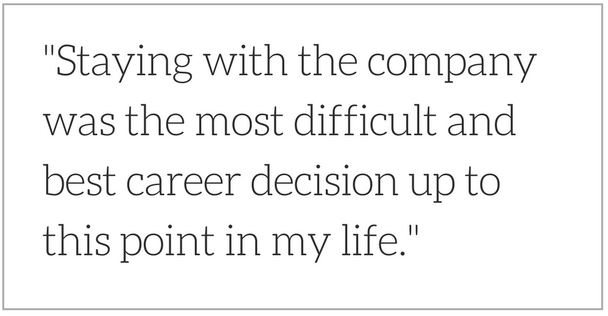
New responsibilities and expectations were set on me to bring value to the team.
Marketing, at the time, wasn’t so valuable.
Worst off, I didn’t touch our marketing software platform again for three months.
Staying with the company was the most difficult and best career decision up to this point in my life.
I’m a marketer. That is my identity. I have no doubts about it.
But the knowledge I gained from shifting roles provided me with a better education than my six years of college did.
Today, I work side by side with our company founders, while supporting senior and executive nonprofit leaders.
An opportunity that isn’t as accessible for most young professionals at larger organizations.
This new perspective has led me to better understand and serve our client’s needs
Something our revived marketing program has benefited from greatly, I might add.
I do believe leadership had envisioned some scenario or outcome like this when they switched my positions function.
Enthusiastic would not be my first choice of words to describe the new role when it presented itself to me.
However, on some level, we all need to grin and bear the reality that leadership has some idea of what they’re doing.
How This Applies To Nonprofit Marketing
Leadership isn’t the enemy.
Perspective is everything, though.
Chances are you don’t know the full picture of how your nonprofit operates.
Only the bits and pieces you’re told or are aware of.
Having access to this information is more of a burden than one might think, forcing difficult decisions.
Trust me when I say nonprofit leaders want nothing more than to provide staff with everything they want, or need, to do their work.
Including the best technology solutions, newest equipment, and even investing in content marketing.
Convincing leadership is not always the case of proving value.
No marketer would disagree in the benefits of content marketing or Search Engine Optimization (SEO) for nonprofits.
However, your executive director, CFO and other purchasing decision makers are more concerned about the ability to pay the bills and preserving cash flow.
When nonprofit leadership makes a decision, you must take the time to comprehend why that decision took place before dismissing it.
It’s not always the case that there is a crusade against you and your department.

To be fair, content marketing for nonprofits can take up to 2 years before results begin to show.
The value is clear, however, the ability to invest a long-term project on this scale is not.
Especially when working with constrained resources.
A common challenge for many small to medium staffed nonprofits.
No amount of data or pleading will persuade a leader in this position.
Content marketing for nonprofits fails for all sorts of reasons, and this failure loses the faith and confidence of your leaders to continue to invest.
Despite its risks, the payoff is incredible when done right.
So how do you “do” content marketing right?
Here are a few questions you should answer to get you started:
- Have we developed a nonprofit marketing strategy to create, curate and distribute content?
- Will nonprofit leadership accept the long-term investment?
- Can my team achieve marketing goals set by leadership?
Does My Nonprofit Have A Content Marketing Process?
Anyone can blog.
Setting up a WordPress site takes no more than 5 minutes.
I’ve done it a dozen times and don’t have a coding bone in my body.
With the exception of a little HTML and CSS.
As a marketing professional, you should know how to build a website, at the very least.
If you don’t know how to, pull out your credit card, spend $25.00, and learn.
It’s a skill set that’s affordable, easy to learn, and will help you improve as a marketer.
I digress.
No, blogging itself isn’t hard.
The challenge is understanding the purpose of your blog and then executing on that purpose.
In other words, developing a content marketing process.
Building a cohesive content strategy is the difference between blogs that increase revenues and blogs that go unread.
70% of nonprofits say they lack an integrated digital marketing plan.
This lack of strategy prevents content from serving a holistic purpose.
Thereby connecting all aspects of your message to donor intent.
Intent meaning what types of content will compel donors to give a charitable gift.
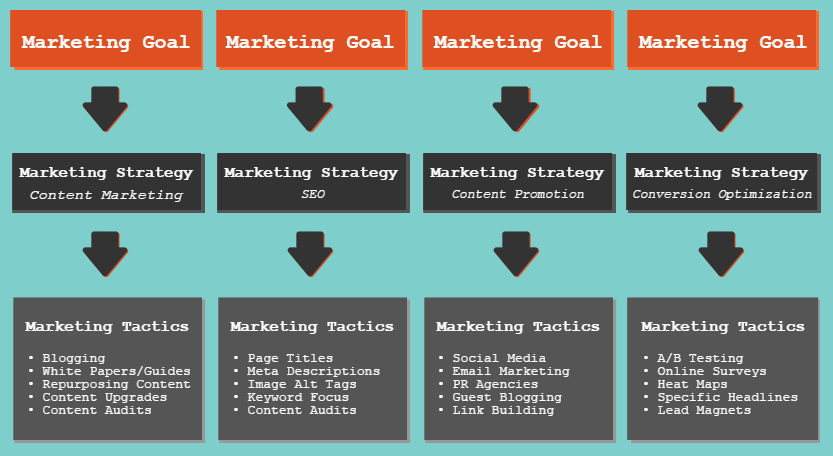
The biggest hurdle that most nonprofit marketers have is in confusing tactics with strategy.
Email marketing is not a strategy, it’s a tactic.
Content promotion, however, is a strategy that leverages all forms of promotion to deliver content to your audience.
You have no right in trying to convince leadership of setting up a content marketing program for your nonprofit if you cannot establish a strategy of how you plan to generate results.
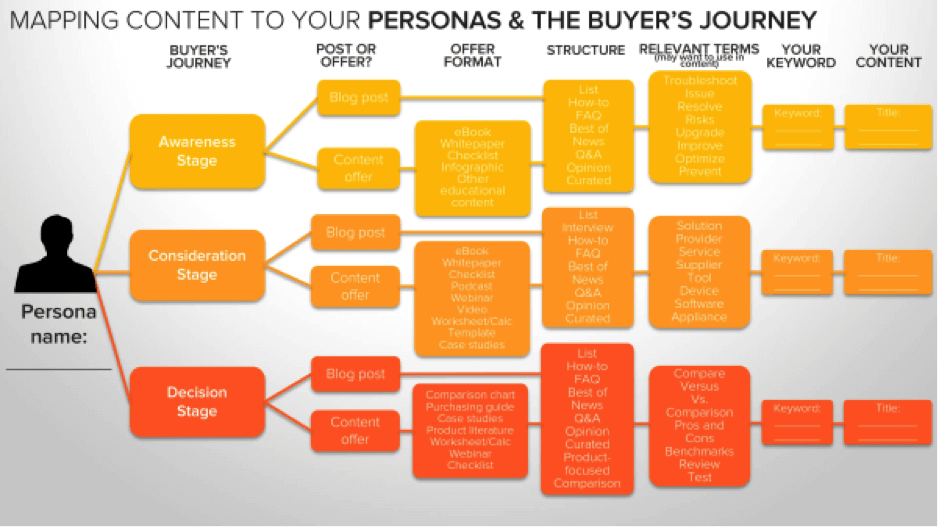
Begin by mapping out your content to support your donor’s journey.
If you haven’t created a donor persona then stop reading and do that now.
The purpose of this exercise is to ensure your message resonates with your audience.

The Environmental Defense Fund (EDF) used donor information in a brilliant way when they advertised on Facebook during Giving Tuesday.
This campaign resulted in a 63% increase in revenues on social media.
EDF used their donor list to target activists on Facebook.
More specifically, they targeted activists who had given an online donation in the last year.
The main takeaway is that EDF positioned their message to donors who were most likely to give, based on information they knew about their audience.
Will Nonprofit Leadership Accept Long-Term Investments
There are two ways to convince leadership of long-term investments:
- Sway leadership with statistics and case studies
- Prove return on investment (ROI) of your marketing activities
We’ve already discussed data-backed statistics are not enough.
This leaves us with one option, proving ROI.
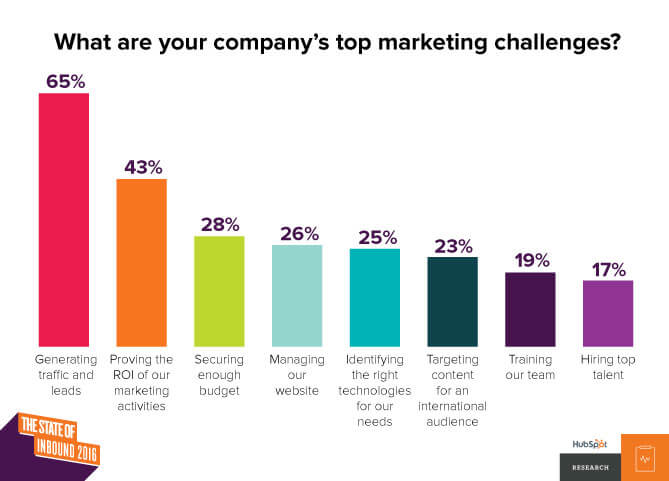
43% of nonprofit marketers say proving the ROI of their marketing activities is a top marketing challenge.
Related Article: 5 Biggest Nonprofit Marketing Mistakes (And How To Avoid Them)

“We can’t guarantee results of content marketing after 2 years, but everyone else is doing it!”
How else is leadership suppose to react to that?
Don’t worry, though, I have a proven solution to share.
The efficiency ratio, also known as the revenue to cost ratio.
This formula a great way to benchmark goals and objectives while providing an accurate way to track results.
The best part of the efficiency ratio is that it doesn’t involve any complex math.
Just basic knowledge of arithmetic.
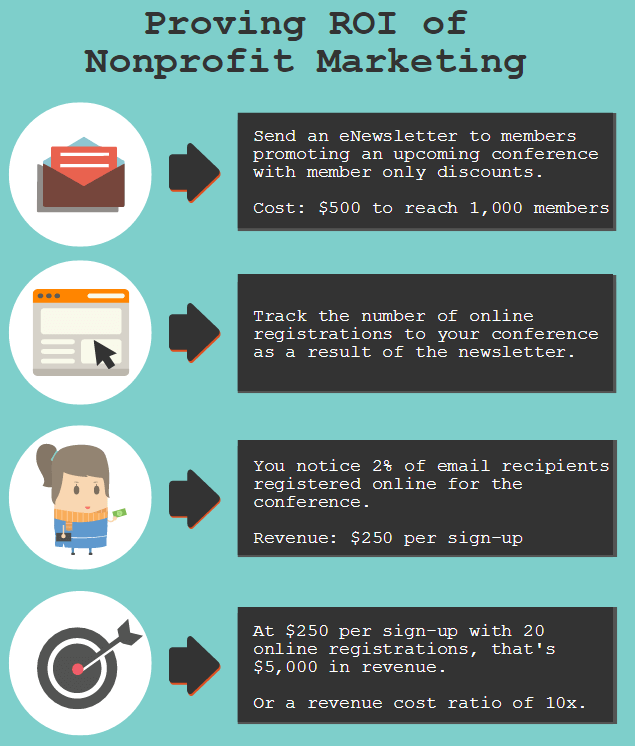
Here’s how you can apply the formula to convince leadership of the long-term investment of content marketing:
- Send a newsletter to members promoting an upcoming conference with member only discounts
- Track the number of online registrations to your conference as a result of the newsletter (URL tracking codes for example)
- Calculate the total revenue from those online registrations
- Use the efficiency ratio to calculate the ROI of your marketing activities
Can My Team Achieve Marketing Goals?
Your team is the biggest difference between success or failure of using content to achieve your marketing goals.
The harsh realities are that marketing for nonprofits can mean staff wears many hats.

Responsibility for online initiatives falls to staff with other activities, like fundraising.
Content marketing is not a direct revenue generating activity, and thus the investment is a luxury.
Without a dedicated team, however, your content will struggle to gain traction.
There is always the option to hire an outside digital marketing agency, but results are never guaranteed.
A $10,000 monthly retainer could literally get your marketing nowhere.

And hiring the wrong in-house talent can cost up to 20% of their annual salary, on average, to replace.
This doesn’t account for the loss of thousands in potential revenues.
The real challenge, though, is that measurable results take some time to realize.
In other words, months can pass before you know if you have the wrong people behind online outreach.
If you’re hiring for a digital marketing position or considering an agency, consider posing this challenge:
- Have a brief unscheduled phone conversation with the candidate/vendor
- Ask the candidate/vendor to evaluate areas of improvement on your site
- If they don’t have immediate recommendations, move on
An unscheduled call will place the candidate/vendor under pressure to prove their application of knowledge.
Talented marketers need to be able to think on their feet.
In this case, it means identifying at least one key area of improvement at a glance.
If the candidate/vendor really wants the job, they will have a report prepared for you in advance with strategies and suggestions of how they plan to generate results.
How Content Marketing Impacts Search Ranking Results
SerpIQ found that content written between 2000 and 2500 words tends to dominate search results.

It may be tempting to start writing 2,500+ word posts in hopes of snagging first page results in Google.
However, first think of what your audience is most receptive to.
Do they really want to read through a novel each time you publish a blog online?
Or, would they rather the condensed version?
Next, consider whether or not you have the resources to devote to long-tailed blog posts.
Even when working full-time, writing content with 2,000+ words can be a time-consuming and often difficult task.
Not only do you need to convey value in your article, but also retain reader’s attention.
Seeing as humans have the attention span less than that of a goldfish, you may need the extra time to focus on storytelling.

Finally, consider this crucial point:
You’ve heard the phrase, “content is king,” and you would be right to assume content is a vital component to nonprofit marketing.
You would, however, be wrong to assume content is the most influential ranking factor.
Of Google’s over 200 ranking factors, backlinks have become the focus of those in the SEO community.
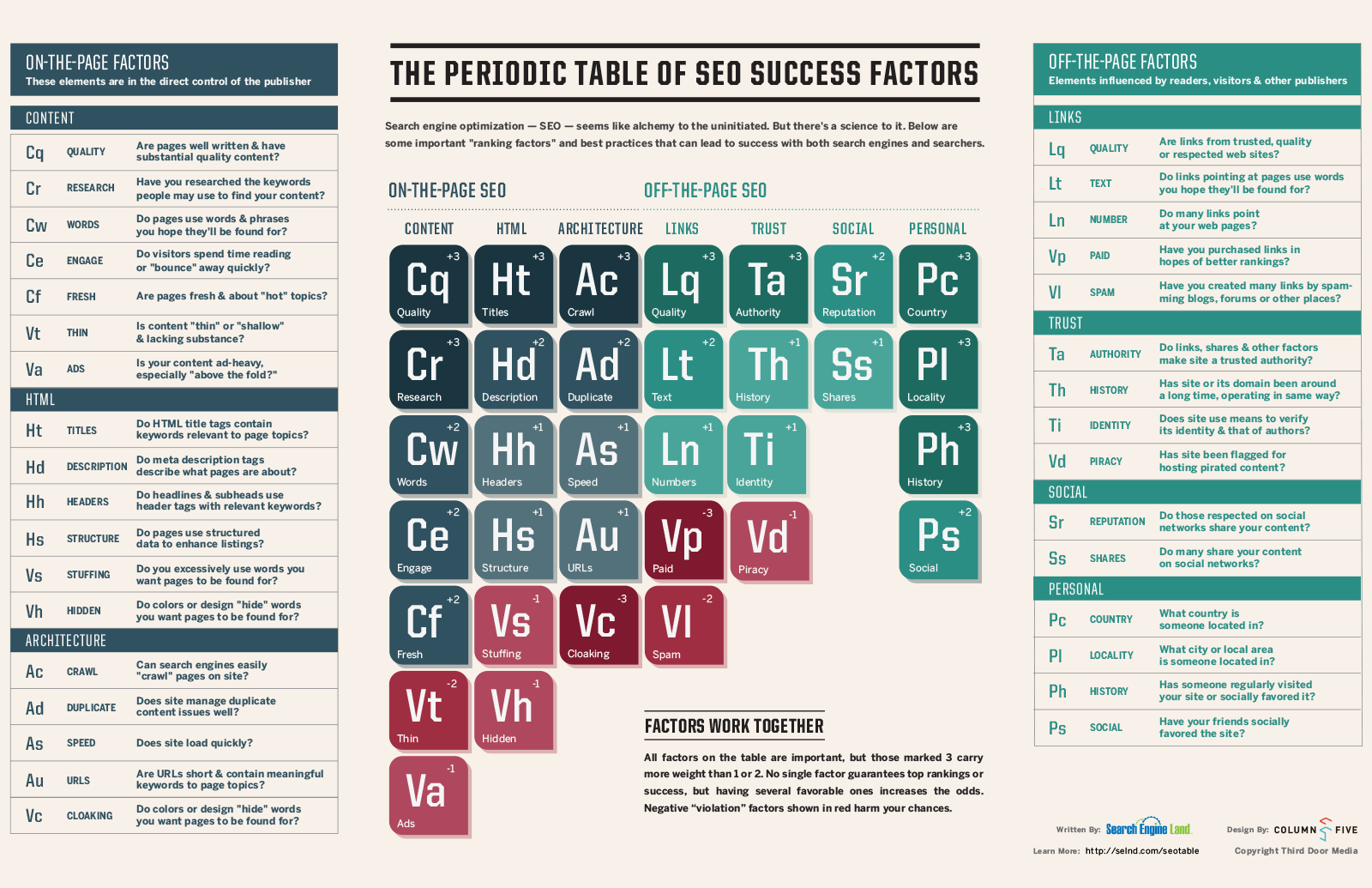
You can blog, create hundreds of pages, share content on social media and still have little to no readership.
If you want your content to show up in search results, and by association increase search traffic, you need to invest in digital promotion strategies that building strong backlinks to your site.
Take a look at National Geographic’s article, “Unbelievably Cute Pictures of Rescued Baby Sloths.”

Their article has over 3,700 views per month or a little over 44,000 per year.

This article does so well because:
- The headline entices a positive emotion from readers
- The blog post tells a story, thereby connecting with the reader
- High-resolution photos and videos to retain attention
- Provides educational material on sloths
Let’s step away from theory and focus in on why this article generates so much traffic.
First, this article has over 550 thousand shares on social media.
Social shares have been proven to increase rankings on Google because they represent social proof of how useful the content is.

Second, the article has 39 backlinks from credible websites, which tell search engines the article is relevant.
As a result, this blog post appears on the first page of Google for high volume search phrases.
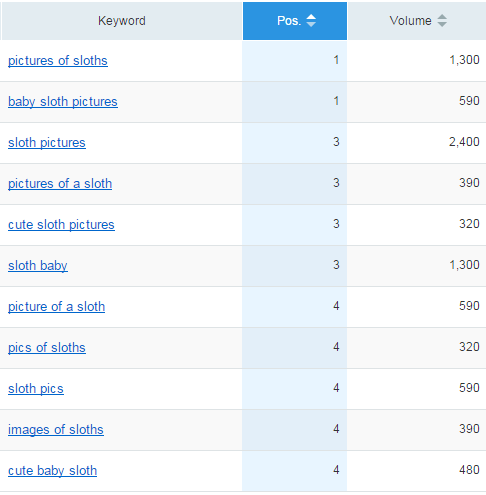
In reality, content and backlinks work hand in hand.
No one will want to link to your content if it sucks.
However, it’s incredibly difficult to create value in a blog post that’s 500 words in length.
But if your content is valuable then the opportunities to generate a backlink increases.
Simply put, you cannot have one without the other if you want your blog to have an impact in search rankings.
How Content Marketing For Nonprofits Influences Donor Behavior
We all have our preferred brands.
Pepsi vs Coke. Audi and BMW. Colgate or Crest.
And with each purchase we draw the conclusion that our choice in brand is the best.
We base this on usage, value, prestige, or because it’s the only brand we’ve ever known.
We choose brands carefully, sometimes creating an affinity so strong that we are willing to defend them from the criticism of strangers.
Often, we associate selection of these brands to our own intellectual superiority.
To stray from our brand would be to stray from our very character.
Despite this strong affinity, our perception of what we consider to be the best is easily swayed.

Giving way to the pressures of advertisement, word of mouth, and yes, content.
How you shape your content and the strategies in promoting your message can directly influence donor behavior.
In fact, 43% of people consume 3-5 pieces of content before making a purchasing decision.
Think about it this way.
When was the last time you purchased a car by choosing the first one you saw on the lot?
A car, unlike toothpaste or soda, is a high involvement purchase.
Therefore, a great deal of research goes into selecting a car prior to making the purchase.
Are you searching for the best value? A safe family car? Or, do you have the luxury of buying that sports car you dreamed of?
Next, you’ll spend a few more hours narrowing the best brand based on your needs (BMW, Audi, Toyota, Ford).
Perhaps you’ll narrow your selection to three models at which point you’ll read reviews online before making a decision.

Donors are no different. Giving to a charitable cause can simulate the feelings of a high involvement purchase.
60% of the sales process happens before a potential donor talks to someone in the development department.
They substitute speaking with the development department for your website’s content.
Donors want, now more than ever, to feel as if they are a part of your organization and they want to see their contributions make an impact.
As a result, donors are more likely to give when they can read or watch personalized stories of how their gift is being used to make a difference.
This positions content as the perfect medium to build a case for why your cause deserves donor attention.
How To Measure Blog Data To Influence Marketing Decisions
You know your donors better than anyone.
Their likes, socioeconomic status, gender, age, location, and so on.
Your donor list is a source of immense data that you can leverage to influence charitable actions through content.
There’s just one problem.
Just because you know who your donors are, doesn’t mean you know what actions they will take when you send them marketing material.
If you can’t predict behavior then you must test and study it to base informed decisions on the direction of your content.
That’s why 78% of marketers use data to influence content strategies.
Luckily, Google offers free analytics and tracking tools to provide this insight and data for you:
- Google Search Console
- Google Analytics
With Google Analytics, you can track website traffic to your site, along with average session and how many pages they viewed.
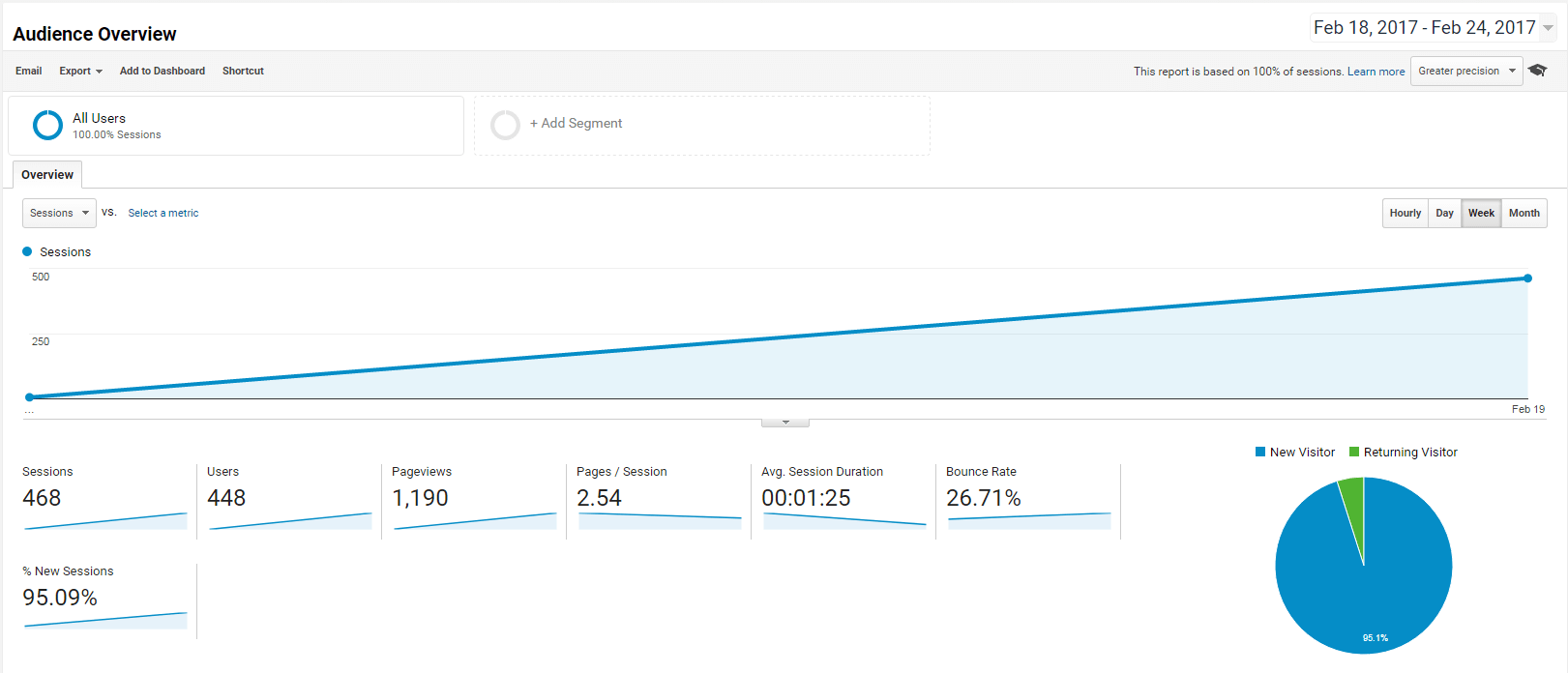
Furthermore, you can view where your top sources of traffic are coming from.
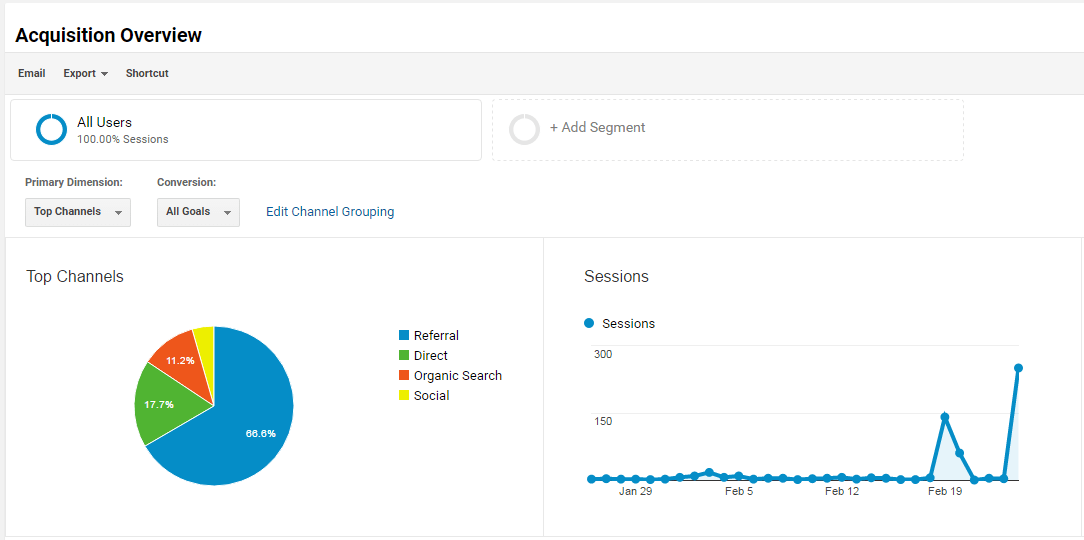
If you notice social media traffic has increased over the last few weeks, then you can prove the effectiveness of your campaigns.
In Google Search Console, you have access to more specific information, like links to your site and most viewed pages.
Best of all, you can view the keywords that your website ranks for, it’s position, how many clicks it receives and how many times your site shows up in search results.

Armed with this information, you can focus on target keywords to rank for while measuring the impact of your results.
These results serve as reports for leadership, thereby proving the value of your content marketing activities.
Here’s how to set up your site to begin tracking and gathering this data.
Google Search Console
Google search console is a free tool that tracks how your site is being crawled and indexed by Google.
This does get somewhat technical, but the payoff in setting this tool up can mean the difference between the first page and last page in search results.
First, you need to set up Google Search Console, formally Webmaster Tools, on your site.
You can use an existing Gmail account to get started.
Click the add the property button.

Then enter your domain.

You can enter the www or non-www version of the domain based on how people search your site.
This is more preference than anything, and you can set up both versions of the site later if you choose to.
Next, you’ll need to verify ownership of your website to connect the search console in order to receive data.

The easiest method is to insert an HTML tag to your site’s header.
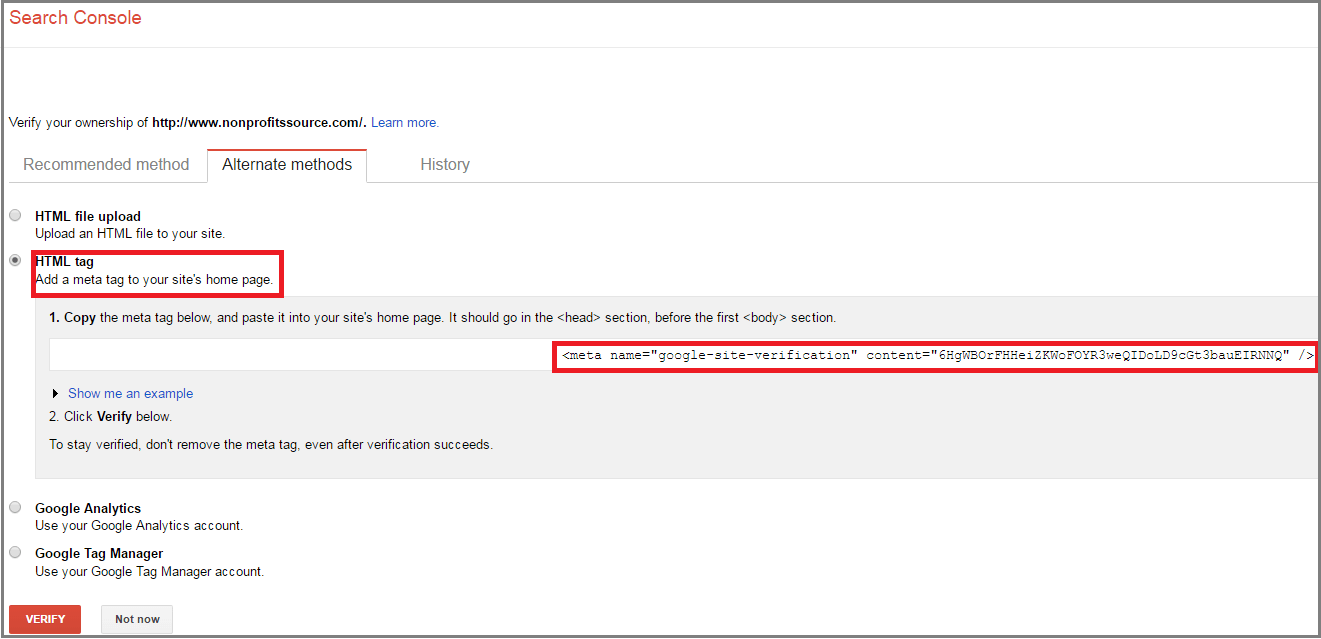
You may need help from your developer to verify ownership of your website if you don’t have access.
If your site is built on WordPress, you can use the Yoast SEO plugin to verify your account in one step.
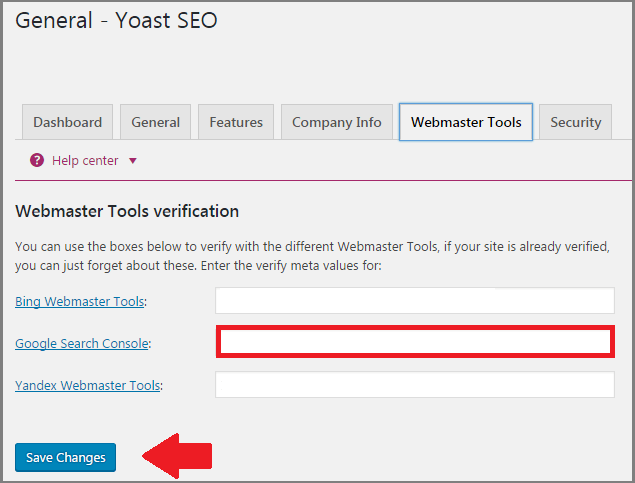
It will take a few days for Google to gather and provide information on your site.
Sitemaps
While you’re waiting, I strongly recommend setting up your sitemap.xml file in Google Search Console.
This delves into the realm of technical SEO, so you may need help from your site’s developer.
Don’t discount the importance of setting up your sitemap file just because you may not feel comfortable with the technical set up.
Not only does it greatly impact Google’s ability to crawl and rank your site in search results, but it’s a basic skill you, as a marketer, need to develop in 2017.
If your site uses WordPress, you can download the Google XML plugin, and a link will be created for you.
A sitemap is a centralized way to link your site’s pages together.
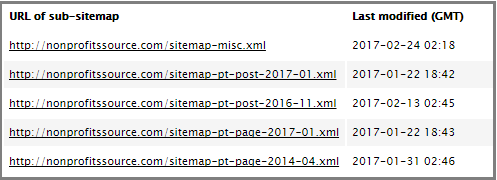
This file tells Google, and other search engines, the location of every page on your site so that it can better index your content.
To add your sitemap file to Google Search Console, use the left navigation box.
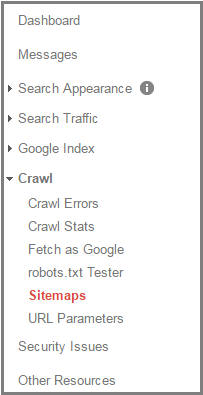
Click on Crawl, and then Sitemaps.
In the upper right-hand corner click the add/test sitemap button, and enter your sitemap.xml address.

Refresh the page and then wait for Google to crawl and index your site.
It will take a day or so for Google to index your sitemap, but the end result should look something like this:
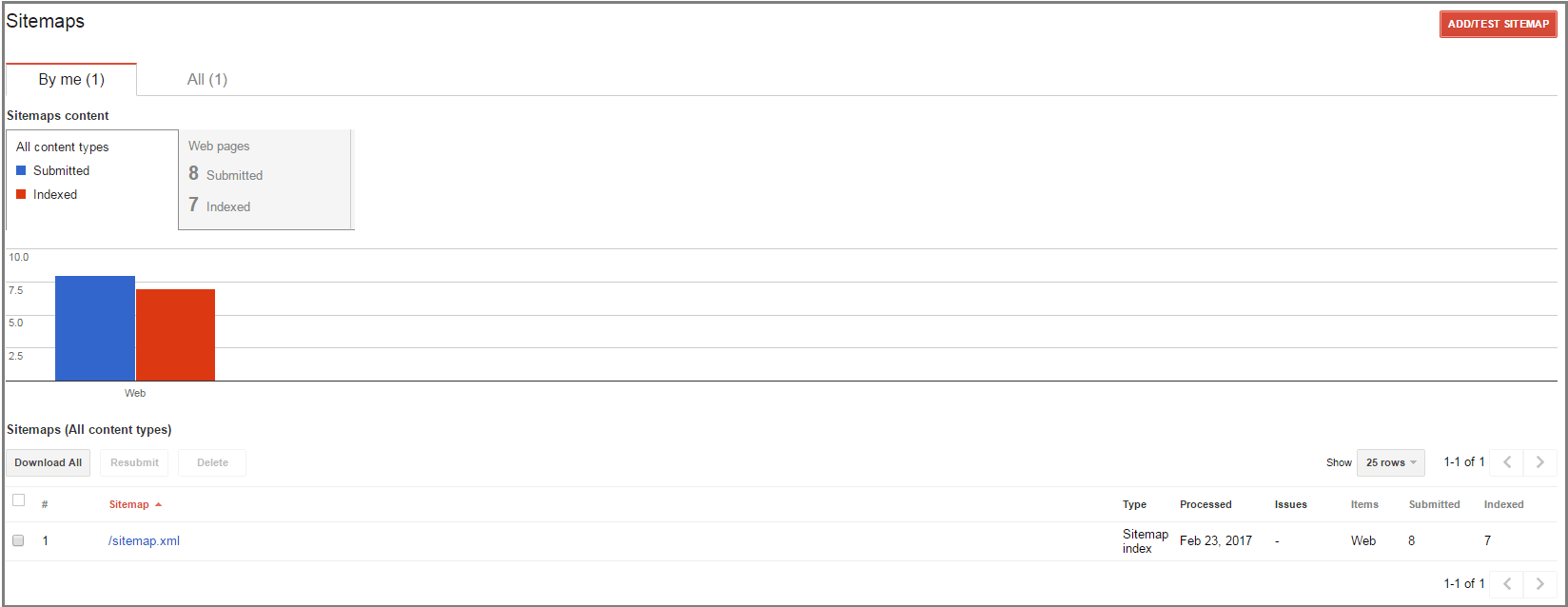
Sometimes Google will report errors in your sitemap if it is not being indexed properly.
Do make sure to fix these errors or else Google will not index your site as intended.
Robot.txt Files
One last technical SEO I would recommend is referencing the sitemap file in your Robot.txt file.
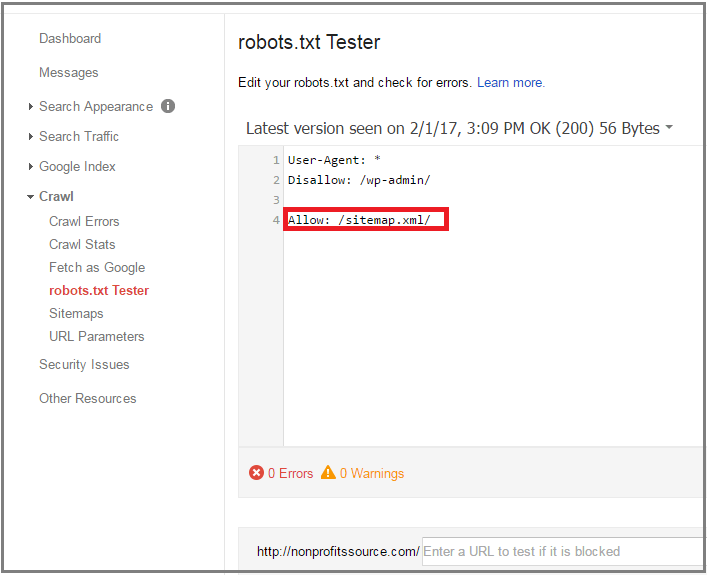
Robot files are a way to block or allow indexing of certain pages on your site by Google.
For example, I tell Google in the robot file to Disallow: /wp-admin/
Therefore when Google crawls my site, it first checks my robot.txt file to see what should and shouldn’t be indexed.
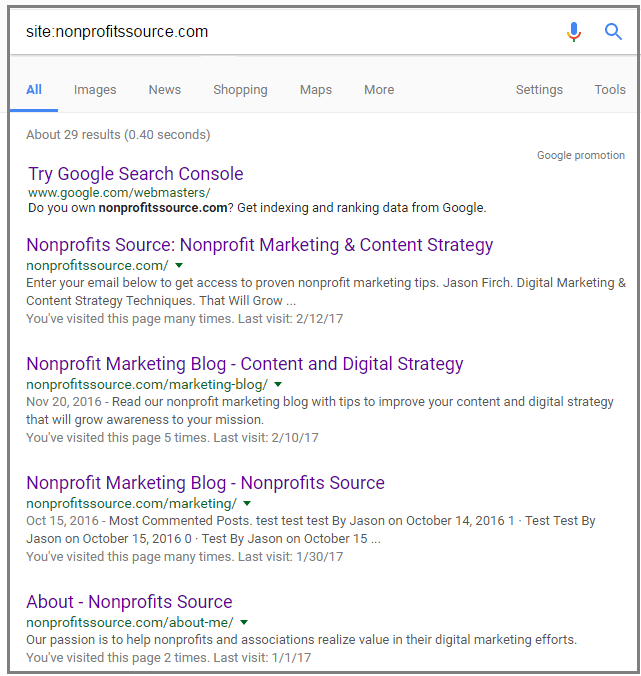
Since I don’t want my /wp-admin/ pages to be accessible in search results, I tell Google to disallow it.
This can be especially helpful if you have pages that need to be hidden from the public for compliance purposes.
Creating the robot file will require access to you cPanel and the root folder of your website.
Don’t freak out. It sounds a lot worse than it actually is.
Your developer will have no issues with setting this up.
Since my site is hosted with Bluehost, I can access my files directly from the dashboard.

Proceed with caution from this point forward.
If you do not feel comfortable navigating your site’s file, then have someone with technical experience do it for you.
If you follow these step-by-step instructions you won’t have issues.
However, you could easily delete a file that could bring down your entire website if you don’t.
Once in the file manager, locate the main root folder of your site and then search for your robots.txt file.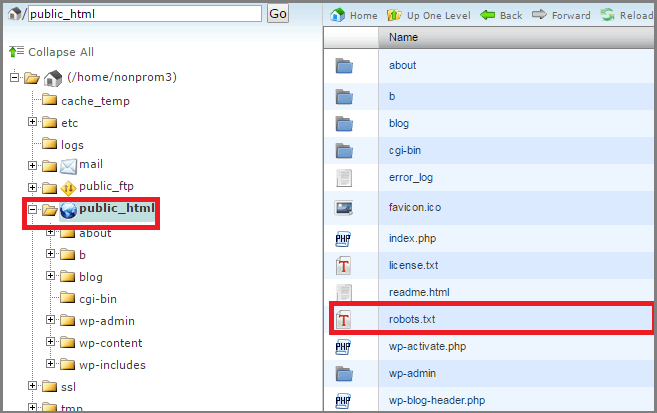
If you don’t have a robots.txt file, you can create a basic text document with the appropriate label.
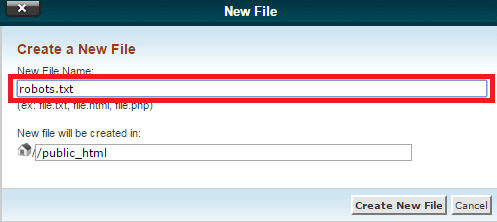
Next, select your robots.txt file to edit it.

Finally, edit the text within the document as follows:

If you want Google to ignore a certain page, type Disallow: followed by the root of the URL address.
In this case, the page nonprofitssource.com/wp-admin/ is being ignored by Google’s indexing.
This also includes any pages with the folder /wp-admin/ within the URL address.
Before you save and close the document, be sure to also reference the sitemap file you created earlier.
By referencing your sitemap file within robots.txt, you’re specifically telling Google to crawl and index your site.
At this point, you should have a Robots.txt file within the root folder of your website as well as a working sitemap.xml file.
The final step is to submit your robot.txt in Google Search Console.
Navigate to Crawl -> robots.txt Tester within Google Search Console.
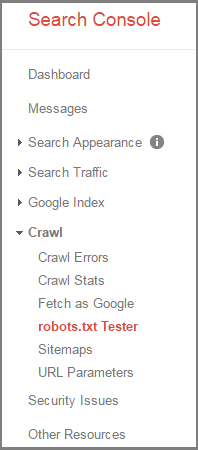
Select the submit button and then use option 3, Ask Google to Update.
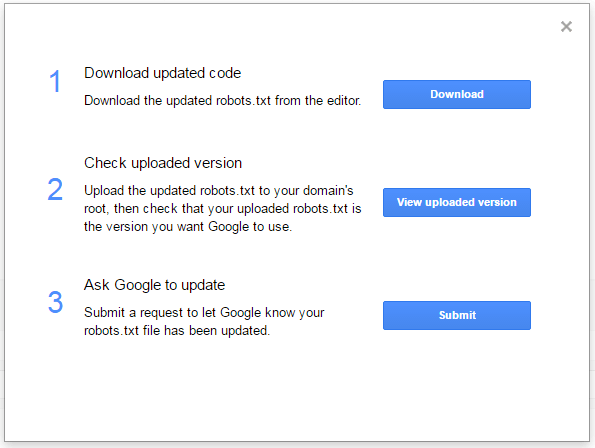
Refresh the page and any updates you made to the robots.txt file will appear.
You can then test the file to ensure it is blocking and allowing traffic as you intend.
![]()
While you won’t see a huge spike in search traffic, this little bit of technical SEO can help your pages index properly and rank faster.
Google Analytics
Setting up your Google Analytics account is as simple as signing into the Gmail account used to verify your Google Search Console.
The two platforms will pair together since they are linked to your account.
Finally, you’ll need to connect your Search Console to your analytics account.
This enables the two platforms to speak with each other and share information.
Under the admin tab of your analytics account select Property Settings.
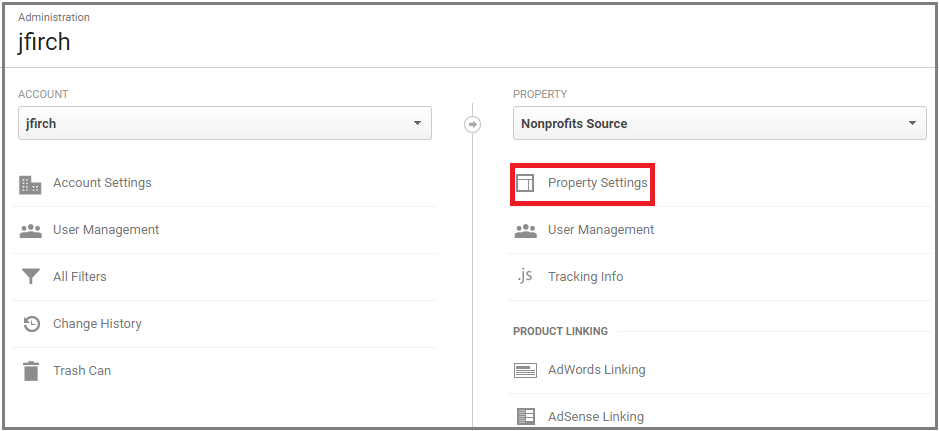
Scroll down to Adjust Search Console.
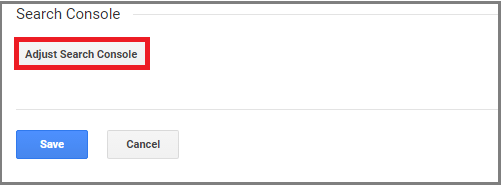
If you have a verified site in Google Search Console it will appear below.

Select the radio button next to the site you want the data to be collected on and hit save.
Congratulations! You’ve successfully connected the Google Analytics and Google Search Console tools to your site.
Be sure to wait a few weeks to a month for a good benchmark of the data before you start use it in strategic decisions.
Conclusion
Today, nonprofits and associations alike are relying on long-term digital strategies to achieve sustainable growth.
Content marketing has spearheaded the charge for one reason.
It works.
Why else would businesses be willing to invest millions of dollars and 12-18 months of time into it?
In the last 5 years, content marketing has also dramatically shaped donors behavior:
- 95% of donors consider content trustworthy
- 43% of people consume 3-5 pieces of content before making a purchasing decision.
- 60% of the sales process happens before a donor talks to someone in the development department
It’s your job, as a marketer, to convince nonprofit leaders of the value of creating content.
Regardless of how many case studies or blogging statistics you cite, it may not be enough to gain full commitment.
However, providing a step-by-step content marketing strategy based on donor persona and donor intent may be the missing piece to sway their decision.
What challenges have you faced with convincing your leaders the importance of content marketing for nonprofits? Let us know in the comments below.

Sign Up For Free Marketing Tips
Do you use digital to grow awareness to your mission? Sign up and get the latest posts on digital marketing for nonprofits.


